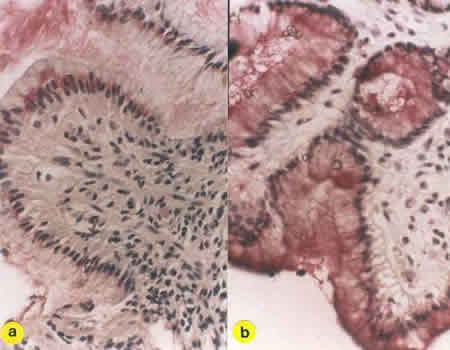Anti-Phospholipase C gamma 1/PLC-gamma-1 (phospho Y783) antibody (ab4828)
Key features and details
- Rabbit polyclonal to Phospholipase C gamma 1/PLC-gamma-1 (phospho Y783)
- Suitable for: IHC-P, WB
- Reacts with: Mouse, Human
- Isotype: IgG
Overview
-
Product name
Anti-Phospholipase C gamma 1/PLC-gamma-1 (phospho Y783) antibody
See all Phospholipase C gamma 1/PLC-gamma-1 primary antibodies -
Description
Rabbit polyclonal to Phospholipase C gamma 1/PLC-gamma-1 (phospho Y783) -
Host species
Rabbit -
Specificity
Phosphorylation site-specific antibody selective for the phosphorylated form of the Phospholipase C gamma 1/PLC-gamma-1 containing a phosphate on tyrosine 783. The antibody has been shown to recognize the endogenous form of Phospholipase C gamma 1/PLC-gamma-1 when phosphorylated on tyrosine 783 in a variety of cell types following treatment by a broad range of extracellular stimuli. Applications include NIH 3T3 cells +/- PDGF. The antibody does not react with a site directed mutant (Y783F).
-
Tested Applications & Species
See all applications and species dataApplication Species IHC-P HumanWB Mouse -
Immunogen
Synthetic peptide corresponding to Human Phospholipase C gamma 1/PLC-gamma-1. Derived from the region of Phospholipase C gamma that contains tyrosine 783, based on the human sequence. This region is conserved among many species including human, rat, bovine and frog (X. laevis)
(Peptide available asab5249, ab5354) -
General notes
Previously labelled as Phospholipase C gamma 1.
Properties
-
Form
Liquid -
Storage instructions
Shipped at 4°C. Upon delivery aliquot and store at -20°C or -80°C. Avoid repeated freeze / thaw cycles. -
Storage buffer
pH: 7.30
Preservative: 0.05% Sodium azide
Constituents: PBS, 50% Glycerol, 0.1% BSA
BSA is IgG and protease free -
 Concentration information loading...
Concentration information loading... -
Purity
Immunogen affinity purified -
Purification notes
Purified from rabbit serum by sequential epitope-specific chromatography. The antibody has been negatively preadsorbed using i) a non-phosphopeptide corresponding to the site of phosphorylation to remove antibody that is reactive with nonphosphorylated Phospholipase C gamma 1/PLC-gamma-1 enzymes and (ii) a generic tyrosine phosphorylated peptide to remove antibody that is reactive with phosphotyrosine, irrespective of the sequence. The final product is generated by affinity chromatography using an Phospholipase C gamma 1/PLC-gamma-1 derived peptide that is phosphorylated at tyrosine 783. -
Clonality
Polyclonal -
Isotype
IgG -
Research areas
Images
-
Extracts prepared from NIH/3T3 (Mouse embryonic fibroblast cell line) cells exposed to PDGF (10 ng/mL) for 10 minutes were resolved on a 10% Tris-glycine gel and transferred to nitrocellulose. Membranes were blocked with 1% BSA, followed by incubation with 0.5 µg/mL ab4828 antibody. After washing, membranes were incubated with goat F(ab')2 anti-rabbit IgG alkaline phosphatase and the signal was detected by chemiluminescence using the Tropix WesternStar detection method and Kodak BioMax ultraclear film. The data show that PDGF is a strong inducer of Phospholipase C gamma 1/PLC-gamma-1 phosphorylation on Y783 in NIH3T3 cells. Extracts prepared from NIH-3T3 cells exposed to PDGF (10 ng/mL) for 10 minutes were resolved on a 10% Tris-glycine gel and transferred to nitrocellulose. Membranes were blocked with 1% BSA, followed by incubation with 0.5 µg/mL ab4828 antibody. After washing, membranes were incubated with goat F(ab')2 anti-rabbit IgG alkaline phosphatase and the signal was detected by chemiluminescence using the Tropix
-
 Immunohistochemistry (Formalin/PFA-fixed paraffin-embedded sections) - Anti-Phospholipase C gamma 1/PLC-gamma-1 (phospho Y783) antibody (ab4828)
Immunohistochemistry (Formalin/PFA-fixed paraffin-embedded sections) - Anti-Phospholipase C gamma 1/PLC-gamma-1 (phospho Y783) antibody (ab4828)ab5163 at a diluton of 1/1000 staining Phospholipase C gamma 1/PLC-gamma-1 (phospho Y783) in formalin fixed paraffin embedded sections of a) inflammed human gastric epithelium and b) normal human gastric epithelium by immunohistochemistry.













